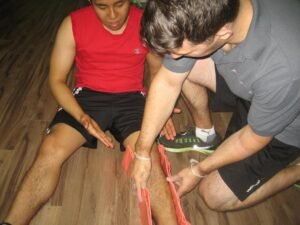The treatment for a broken leg depends on the severity of the injury. A broken leg is quite common especially among the elderly during falls, vehicular accidents or when engaged in contact sports such as football, soccer or hockey.

First aid for a broken leg
- Always observe safety first and make sure that the individual is in a safe location. It is vital to ensure your safety and the individual first. Observe the universal precautions and use appropriate protective gear if available.
- Check the ABC in first aid – airway, breathing and circulation. Take note that a broken leg can be considered as distracting injuries but most of the time the condition is actually worse than what it appears.
- Always control the bleeding if present. This is done by applying direct pressure over a clean cloth. If the bleeding could not be controlled, call for emergency assistant as soon as possible.
- Inspect for other possible injuries. In case the individual has signs of injury to the head, back or neck, avoid moving the individual. This will help minimize further damage.
- Wounds on the skin must be covered with sterile dressings. If possible, the wound must be rinsed using saline solution or sterile water.
- Once you have called for emergency assistance, the individual must be instructed to stay still. If needed, the broken leg must be splinted to ensure that the joint is immobilized but make sure that it is not wrapped too tightly.
- Ice can be applied on the affected leg to minimize the swelling. Do not apply ice directly and make sure that a cloth or towel is placed in between the ice and the skin to prevent frostbite from developing.
- The affected leg must be elevated above the heart level if possible.
- Allow the individual to rest on his/her back to prevent the signs of shock from developing. Do not forget to cover the individual with a blanket.
Always remember not to move the individual if there is suspected neck, head or back injuries. Do not attempt to move the individual who has a broken leg unless needed for the safety of the victim and the rescuers. Avoid straightening the broken leg or alter its position unless the foot of the individual is bluish in color, cold, numb or paralyzed. You can try to return a deformed leg to its anatomical position.
Call for emergency assistance if the damage is above the knee or accompanied with other injuries such as a broken pelvis, broken hip, injured neck or back or even an injury to the head. If splinting is required, you have to apply one before the medical team arrives by using a long wooden spoon or a broom handle.
